Free download: Top 10 Natural & Easy Remedies for Joint Pain from Home. Learn these helpful remedies.
Estimated Reading Time: 11 minutes read
Whiplash injuries are commonly heard of, but how to actually treat whiplash pain isn’t widely understood.
To treat a whiplash injury, we must first understand the basics of what it is and the associated symptoms.
Once we have a grasp on these areas, then an effective treatment plan can be put into place.
Table of Contents
What is a Whiplash Injury?
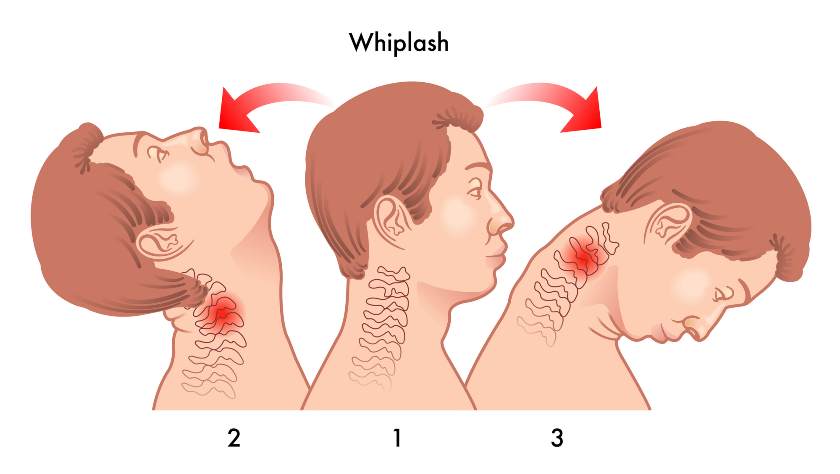
A whiplash injury occurs in the neck. It’s a forceful, usually traumatic injury. It involves a rapid motion of the head backward, then forward.
Similar to its name, whiplash feels like your head and neck has been whipped back and forth.
Whiplash usually causes neck pain related to subsequent soft tissue injuries in the cervical spine. These injuries may involve muscles, tendons, ligaments, nerves, and spinal discs.
Causes of Whiplash

Whiplash is not a naturally occurring injury. It is typically caused by some type of forced trauma.
The most common causes include the following:
- Car accident, typically rear-endings
- Traumas, such as a fall or physical abuse
- Sports injuries, particularly contact sports
Risk Factors for Whiplash
Any individual with a hypermobile neck or those who are older with more fragile joints and soft tissues are considered to be at a higher risk for whiplash.
You can also have an increased risk if you have a history of neck pain from an old whiplash incident.
Whiplash Symptoms

If you have experienced whiplash, you very likely have noticed one or more of the following common symptoms:
- Neck pain either immediately or slightly delayed after the initial injury
- Decreased neck range of motion
- Numbness or tingling in the arm or hand
- Neck stiffness
- Shoulder pain
- Mid or lower back pain
- Dizziness
- Fatigue
- Ringing in the ears
- Difficulty concentrating
- Blurred vision
- Headaches
- Disrupted sleep
- Irritability
- Poor memory
Types of Whiplash
According to the BC Medical Journal, whiplash can be categorized into different types, depending on the severity of symptoms.
- Type 1: Mild case. You may not notice neck pain until a day or days after the injury. Symptoms are mild and usually more localized to the neck without radiation. You may not notice a significant amount of reduced neck motion.
- Type 2: Moderate case. This is slightly more severe than Type 1. You likely will notice pain at the time of the injury versus a delayed onset. You may notice radiating, painful symptoms, but not necessarily numbness or tingling.
You probably will have reduced and painful neck range of motion, possibly related to tension or spasms in the neck muscles.
- Type 3: Severe case. This is considered a more severe injury. You will likely have nerve involvement with your radiating symptoms, as well as more severe symptoms such as a headache, muscle spasms, fatigue and difficulty concentrating.
Diagnosing Whiplash
Physical Examination

It’s important to seek a consult by a healthcare provider, such as your primary care physician, if you have experienced a whiplash trauma.
Your doctor will perform a physical exam to assess your symptoms. An initial medical history intake will be performed, as well as questions about the injury itself.
They will look at your neck range of motion, as well as test reflexes, strength in the neck and/or upper body, sensation, and assess areas of tenderness in the neck muscles.
Imaging Tests

As a whiplash is typically the result of a traumatic event, your doctor may order imaging tests to get a better view of the cervical spine and surrounding soft tissues, as well as rule out other possible injuries, such as a fracture.
An X-ray will show the basics of cervical spinal alignment, and that no fracture is present. X-rays are not the best for showing soft tissue damage.
Computerized tomography, or a CT scan, is considered the next step up from an X-ray. A CT scan will show more details involving bone injuries, soft tissue, and organs.
Magnetic resonance imaging, or an MRI, is considered more detailed than a CT scan. An MRI shows very specific information regarding the soft tissues in the body, in particular.
Treatment for Whiplash
Your doctor will assist in providing recommended treatment options to relieve your neck pain.
Depending on your exact symptoms, you may be referred to another specialist, such as a neurologist.
More often than not, your doctor will refer you to physical therapy to address your neck pain and assist in recovery.
Pain Management
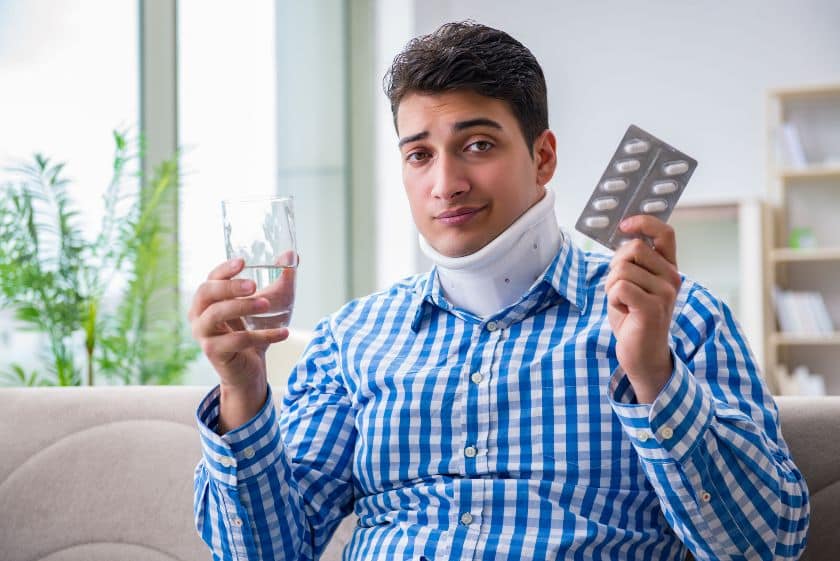
Various measures of pain management may be recommended by your doctor in the initial phases of recovery to help decrease pain.
This may initially involve resting the injured area. Your doctor may also recommend prescription medications, such as muscle relaxants and anti-inflammatories.
If the injury is severe enough, your doctor may recommend briefly wearing a neck brace to keep the neck stable and ease neck pain. You’ll want to avoid extended use of a neck brace though, as this can actually hinder your recovery.
The sooner you’re able to actively, but gently, use your cervical and back muscles, the faster you will heal.
Additional pain control strategies are typically discussed and provided by your physical therapist.
Physical Therapy

The goal of physical therapy is to reduce pain and restore functional use of the head and neck.
If you’re experiencing more intense pain and limitations initially, your physical therapist may need to include more passive treatment measures.
This may include manual therapy or other modalities (e.g., massage, electrical stimulation, ultrasound, a heating pad or ice pack, dry needling).
With regards to manual therapy, it’s not recommended to utilize strong neck manipulations as this can further pain or damage injured tissue, and can slow your recovery.
Exercises for Whiplash
Whiplash exercises will be included in your physical therapy as initiating active movement of the injured neck, in a controlled manner, is one of the best ways to help reduce whiplash pain.
Exercises will be focused on restoring range of motion, as well as strength and stability in the neck and surrounding muscles.
Below are a few examples of common exercises for whiplash you may be prescribed in physical therapy:
1. Cervical Range of Motion
It’s important to practice gentle cervical spine range of motion, without increasing pain. Never force the motion.
Practice improving the quality of your movement every direction your neck is able to move.
For all of these motions, you will begin in an upright posture either in a standing or seated position.
a. Forward Bending

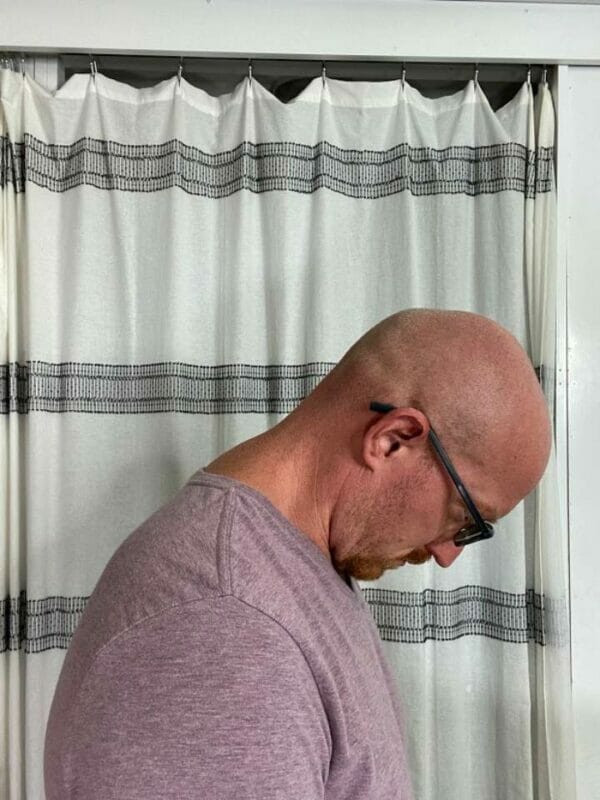
- Gently and slowly bend the head and neck forward until you feel a comfortable stretch on the back of the neck.
- Hold for 2 seconds, then return to your starting position.
- Repeat 5-10 repetitions for 2 sets.
b. Backward Bending
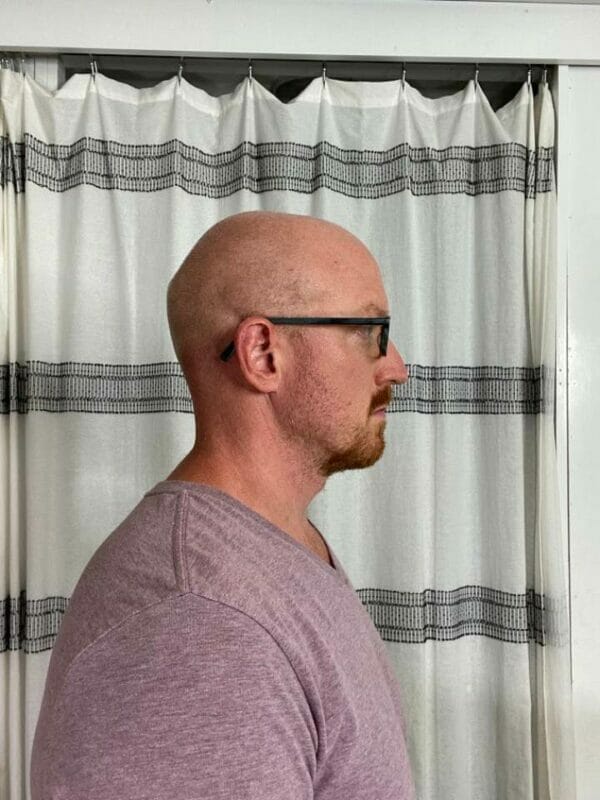
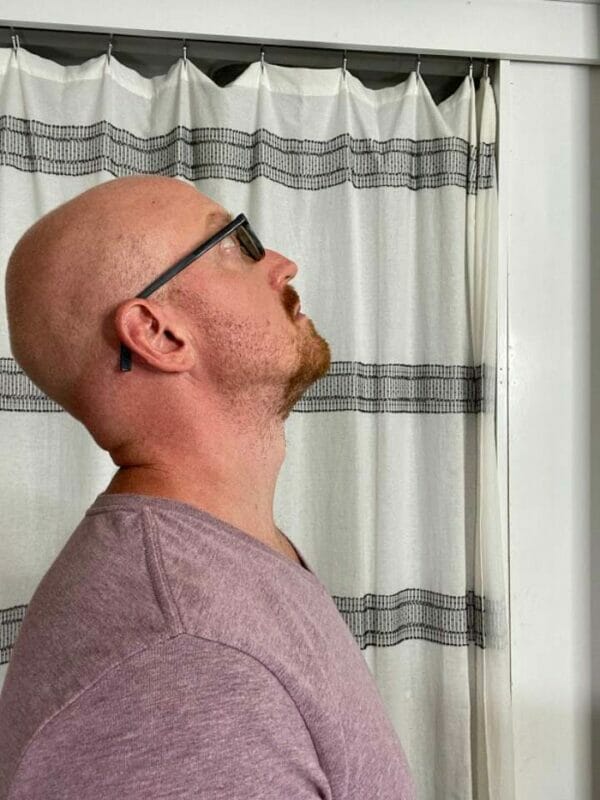
- Gently and slowly bend the head and neck backward. Do not push into pain.
- Hold for 2 seconds, then return to your starting position.
- Repeat 5-10 repetitions for 2 sets.
c. Side Bending


- Gently and slowly bend the head and neck to one side at a time, practicing on both the left and right sides.
- You should keep your nose pointing forward and try to move your ear towards your shoulder.
- Hold for 2 seconds, then return to your starting position.
- Repeat 5-10 repetitions for 2 sets.
d. Rotation


- Gently and slowly turn the head one side at a time, practicing on both the left and right sides.
- Make sure you don’t force the motion.
- Hold for 2 seconds, then return to your starting position.
- Repeat 5-10 repetitions for 2 sets.
Generally speaking, try to keep the neck and shoulders as relaxed as possible during these motions.
2. Chin Tuck
The chin tuck is meant to help strengthen the neck flexors in the front of the neck. This will help to keep a neutral head alignment, versus allowing the head to move into a forward resting position.

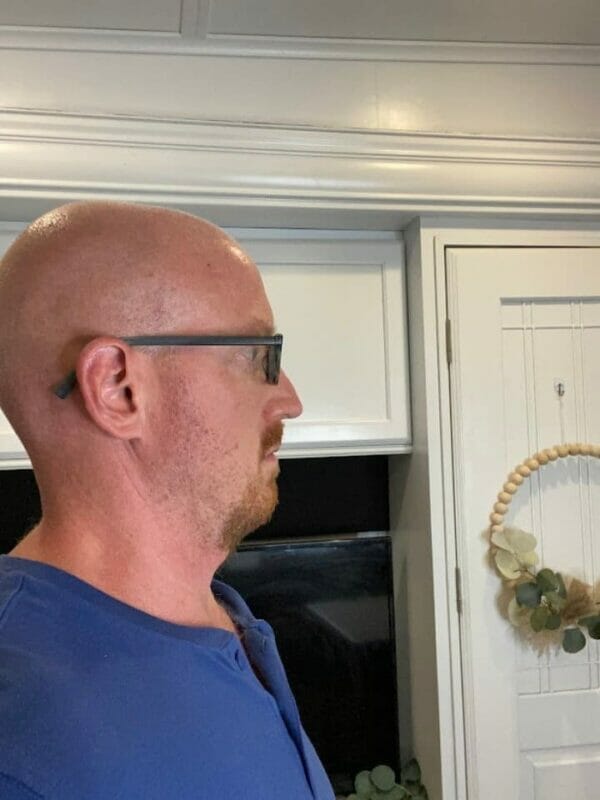
- You can perform this exercise laying down or upright in sitting or standing.
- Gently retract the chin, as if you were trying to make a double chin.
- Hold for 5 seconds, then return to your starting position.
- Repeat 10-15 repetitions for 2-3 sets.
3. Cervical Isometrics
An isometric exercise is a sub-maximal contraction. It’s meant to re-introduce gentle contractile forces in muscles without moving through full range.
The cervical spine isometric exercises will be practiced in each direction the neck is able to move with manual resistance provided by yourself.
It’s important to remember this is a sub-maximal contraction, so do not use a heavy amount of pressure.
You will be in an upright position for these isometrics, either in standing or sitting.
a. Forward Bending

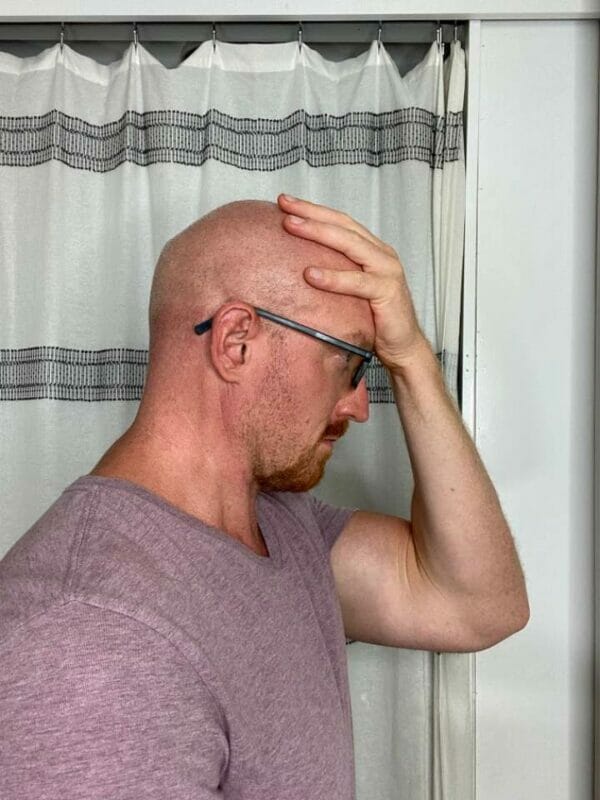
- Place one hand on your forehead.
- Allow for a subtle forward motion of the head as your hand gently resists with an equal amount of force.
- Hold up to 5 seconds, then relax your pressure.
- Repeat 10 repetitions for 2 sets.
b. Backward Bending


- Place one hand on the back of the head.
- Allow for a subtle backward motion of the head as your hand gently resists with an equal amount of force.
- Hold up to 5 seconds, then relax your pressure.
- Repeat 10 repetitions for 2 sets.
c. Side Bending


- Place one hand on the side of the head. If you’re using the right hand, place it on the right side of the head, and vice versa.
- Allow for a subtle side bending motion into the hand as the hand gently resists with an equal amount of force.
- Hold up to 5 seconds, then relax your pressure.
- Repeat 10 repetitions for 2 sets on each side.
d. Rotation


- Place one hand on the side of the head. If you’re using the right hand, place it on the right side of the head, and vice versa.
- Allow for a subtle rotation motion into the hand as the hand gentle resists with an equal amount of force.
- Hold up to 5 seconds, then relax your pressure.
- Repeat 10 repetitions for 2 sets on each side.
Tip: If you experience pain during any of the isometrics, check to make sure you’re not using to much manual force.
e. Upper Trapezius Stretch


- Begin in an upright position either sitting or standing.
- You’ll be stretching one side of the neck at a time.
- If you plan to stretch the left upper trapezius muscle, bend your head to the right.
- Take your right hand and place it on the left side of the head to give a gentle overpressure into the stretch.
- Hold at least 30 seconds or up to 1 minute.
- Slowly release the pressure and return to your starting position.
- Repeat on the other side.
f. Levator Scapulae Stretch


- Begin in an upright position either sitting or standing.
- You’ll be stretching one side of the neck at a time.
- Similar to the upper trapezius stretch, begin by bending the head to one side. Let’s say to bend the head to the right, in order to stretch the left levator scapulae muscle.
- Once in side bending, turn the head down and to the right.
- Take your right hand and place it on the left side of the head to give a gentle overpressure into the stretch.
- Hold at least 30 seconds or up to 1 minute.
- Slowly release the pressure and return to your starting position.
- Repeat on the other side.
How to Do Self-Trigger Point Release Using a Tennis Ball
In this video, I show some pretty easy steps on how to do self-triggered point release using a tennis ball. This technique is great for releasing trigger points caused by sitting at your desk, or in an office chair all day long and can be practiced anywhere.
Recovery Time for Whiplash Injury

How long does whiplash last?
The length of recovery depends on a few factors, but primarily the severity of the whiplash. On average, it can take anywhere from several weeks to a few months to make a full recovery.
Those who experience very severe symptoms of whiplash pain or who already have a history of a previous whiplash injury, unfortunately may still have ongoing residual symptoms.
These chronic symptoms are not as common and typically not as severe as at the initial pain onset.
Be Proactive
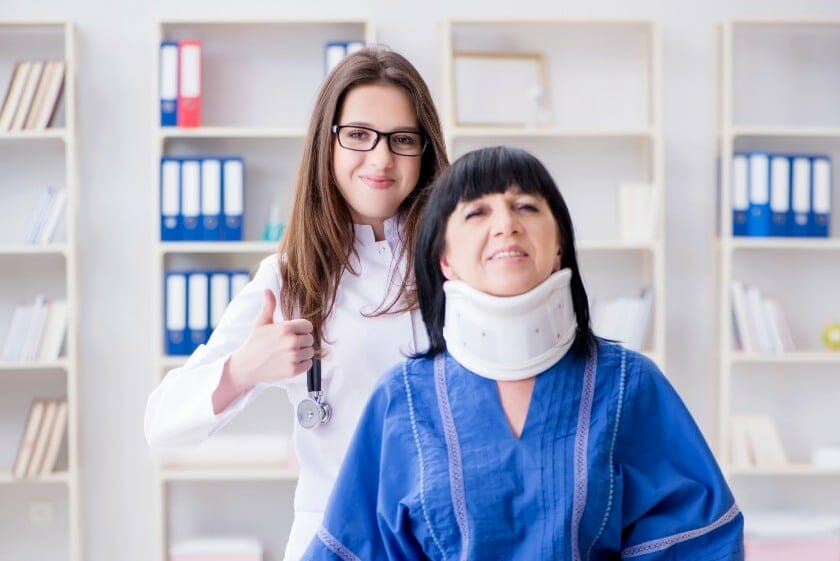
If you have suffered a whiplash injury, don’t wait to have your symptoms and pain addressed.
Seek help from a medical professional right away, so that you can begin treatment sooner than later.
By doing this you will greatly improve your chances for a fast and full recovery.
FAQ:
Can I drive after a whiplash injury?
Most are usually able to drive after experiencing whiplash; however, do NOT drive if you are experiencing dizziness or if turning the neck while driving is so severe it impedes your ability to safely maneuver your vehicle.
Can whiplash heal on its own?
More mild cases can typically resolve on their own. Even so, due to a whiplash being a traumatic injury in most cases, it’s still best to consult with your doctor for a full examination.
After whiplash, should I avoid moving my head?
No.
Do try to gently practice head and neck range of motion. Don’t force the motion into a painful range, but try to keep yourself moving as much as possible.
















